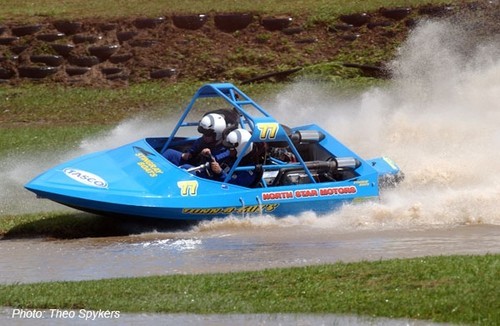Wild Action - Australian V8 Jetboat Championships
by Rob Kothe Powerboat-World.com on 1 Oct 2007

Australian V8 Jetboat Championships Round 8 SW
Tweed Valley’s Jet sprint club, Cabarita track is located about 10kms from Tweed Heads. It was the scene of the 8th round in the Australian V8 Jetsprint Championships on September 23rd. The Group A speedster Tunn-a-Guts came unstuck
Theo Spykers was on the spot and captured this sequence.
It was a glorious day for racing but this incident could have turned really ugly, had it not been for the superb efforts of the safety crew.
[Sorry, this content could not be displayed]
[Sorry, this content could not be displayed]
[Sorry, this content could not be displayed]
[Sorry, this content could not be displayed]
[Sorry, this content could not be displayed]
These amazing pictures from the V8 Jet sprinting spectacular prompted us to provide a little more detail on this sport.
Since its humble beginnings in New Zealand 20 years ago V8 Jetsprint racing has developed into one of the most exciting forms of motor sport that exists today.
Likened to rally driving on water, the boats can accelerate from 0 to 160km’s in under two seconds while completing 180 degree corners pulling 5-6 G’s similar to those found in a F-111 fighter jet. It is a visual spectacular unseen in any other form of motor sport that translates well not only to the spectator but to a wider television audience.
On the back of this incredible excitement the world of V8 Jetsprinting is continually growing in popularity around the world. There are tracks and National Championships held in New Zealand, Australia and The United States of America every year.
A typical Jetsprint course is built in an area the size of a football field, consisting of a series of channels 4 to 8 metres wide, with a water depth up to one metre (3 feet).
The boats have a driver and navigator who negotiate the channels in a pre-determined order given to them on race day. The race usually involves 25-30 directional changes in a run that takes less than a minute to complete.
It's the ultimate test of man and machine against the clock, a test where the difference between winning and losing is often within hundredths of a second.
Each competitor has three qualifying runs with the top 16 crews progressing to the 'sudden death' elimination rounds. There are no second chances as the field is halved in each round, reducing from 16 to 8 to 4 down to the two crews who will contest the Final top two shootout.
A typical race route would be; START,10,9,2,3,7,9,8,3,6,5,1,2,3,6,4,3,2,9,7,6,FINSH
The boats are amazing. Likened to putting a drag car engine in your average Aussie aluminium dinghy, the boats themselves are unusual in their design and are built especially for this sport. They are made of aluminium and weigh between 450 and 600 kilograms. With some engines producing up to 1200 horsepower it provides an amazing power to weight ratio virtually unseen in any other motor sport.
Steering is through a rear nozzle which directs the jet unit output. There is no rudder and the boat can only steer when power is applied. Boat jet units have a water throughput of up to 2800 litres per minute. This gives them incredible maneuverability enabling them to turn 180 degree corners at speeds unseen before.
This is the 2007 Calendar Season for the Australian titles.
CABARITA
February 10th & 11th
Practice weekend
TEMORA
March 11th
NSW Points
MELTON
March 25th
Australian & Victorian Championship Points
ALBURY
March 31st
Australian & NSW Championship Points
GRIFFITH
April Easter
NSW Championship Points
MARYBOROUGH
May 6th
QLD Championship Points
CABARITA
June 10th
Aust & NSW Championship Points
MARYBOROUGH
September 2nd
Australian & QLD Championship Points, QLD Final
CABARITA
September 23rd
NSW Points
MELTON
October27th
Melton Victorian Points, Victorian Final
TEMORA
November 3rd
Aust & NSW Points
ALBURY
December 8th
Aust & NSW Points, NSW Final Australian Final
If you want to link to this article then please use this URL: www.sail-world.com/37917